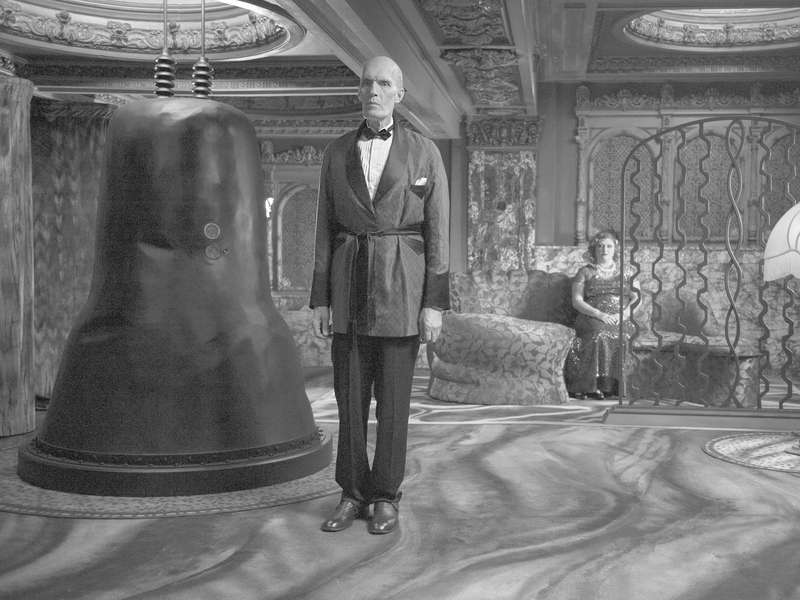
Twin Peaks: The Return - Episode 8 "Gotta Light?"
Slead Score: B
Whelp, the coherence was fun while it lasted.
Despite jumping back into the void that is Lynch's mind, this truly unusual hour of television was something to behold. Perhaps it's the fatigue of wondering week to week if we'll ever get a traditional Twin Peaks experience in this new season, or maybe it's Stockholm syndrome at its most potent level. Regardless, the mysteries that we were warmly embraced with last week have taken a back seat to give honor to the surrealist filmmakers of the world. While most film students are well versed in experimental works like those of Maya Deren, most audiences will sit through five minutes of space scenes filled with gas and then promptly turn off the TV. Of course, being "well versed" doesn't always equate to enjoyment; especially in this case. However, if we can give Lynch one prop, it's how he manages to defy expectations at every turn. Last week we had arguably the most coherent and straightforward episode of The Return so far, only one week later to be slammed as far into experimental as anyone would ever imagine going. The great thing about episode 8 is that as experimental and head scratching as it is, it tells an interesting story of Twin Peaks and human nature as a whole.
Before we jump into crazy town, the opening act of "Gotta light?" does pick up from the plot we left off in the last episode. Mr. C, better known as Bob-possessed bad Cooper, has taken his getaway car with the help of Ray and is heading to the mysterious coordinates he's been hinting at for weeks. Of course, he must check off his evil deed for the day, which this time involved killing Ray in an empty field. However, Ray turns the tables and pulls a gun on Mr. C. Two bullets to the gut, and Mr. C is down, until several ghostly Charcoal Men rush over to his body, smearing it with blood, and seemingly revive him. All the while Ray screams to then finally run to his car to phone a warning to his comrades. We then cut to the Roadhouse in Twin Peaks, where Nine Inch Nails takes the stage to perform the longest and darkest song we've heard this season. Of course, both of these scenes feel like Twin Peaks and were an excellent precursor to what we experience for the remainder of the time.
Now, with that out of the way, Lynch then spends a good 25 minutes showing us the inside of an atomic bomb blast. Cutting back to 1945, the mushroom cloud of the explosion seems to hold more than radioactivity and death, a floating Bob head flies toward the screen, giving the nod to the idea that this evil spirit that has haunted Twin Peaks for so long is much older than we knew. Acting as an antithesis to this moment, a fortress alone on an island in the middle of what could be an ocean or just the void of space houses a woman and the giant from the Great Northern. As an alarm blares for attention, the giant switches off the warning to later release a cloud that transforms into Laura Palmer's face. The other inhabitant of the fortress, a well-dressed woman, kisses the Palmer bubble and it flies away, much like Bob's from the nuclear cloud. Two spirits of opposing forces have been let loose into the world, and this is where Lynch and Frost may be tipping their hat toward a conversation on the origin of good versus evil. The Biblical God versus Satan narrative is usually the most commonly referred to the root of these undefinable terms, but we're talking Twin Peaks now, so of course, what better way to depict the source of the struggle than Laura versus Bob. While this is a reading and not fact, it's hard to ignore the themes and works that Lynch has delved into in the past, including the original run of the show.
Twin Peaks has always been about more than Laura Palmer. In fact, if Lynch and Frost had their way in the original run of the series, we still wouldn't know who killed the prom queen because it was just the catalyst to analyze what fascinates Lynch most: Americana. From Blue Velvet to Inland Empire, Lynch has always seemed enamored with the idea that evil is lurking just underneath a white picket fence, and often that evil has been there for longer than we can imagine. In this episode, we get just that, evil and good being born, perhaps not into the entire world, but into the town of Twin Peaks. Again, this will probably never be definitively confirmed or denied, but as a viewer who loves what Lynch can do, these are the types of conversations that are worth having. This thought carries through into the episode's final and terrifying moments, as a Charcoal Man terrorizes a small New Mexico town. Asking for a light for his cigarette, the man just obliterates a radio D.J. and their receptionist to give an incoherent monologue. Meanwhile, a young teen couple exchanges their ideas of love for one another, only to have a small bug crawl into the girl's head and start something nefarious.
Again, these are primal discussions happening here, leaving a majority of the dissection up to interpretation, as garish as that might sound to some. However, I found this stark departure actually welcome because it accomplishes what I've always loved about Twin Peaks and Lynch's work in general. It uses art to start conversations and ideas, but never feels too self-important to act as if it has the right answer. I'll especially take more of this week and last week if it means less of Dougie throwing his thumb and peeing his pants while Naomi Watts yells at him.

